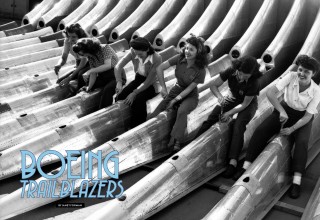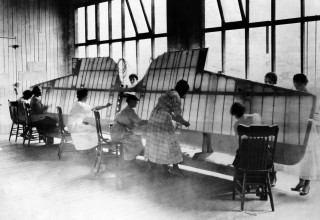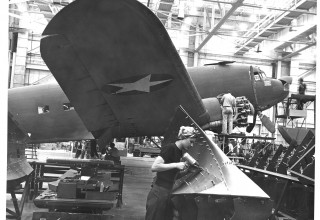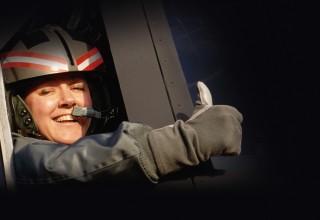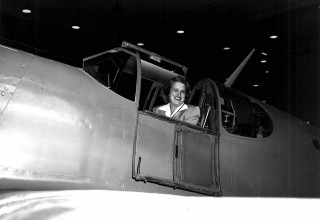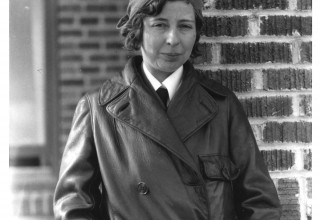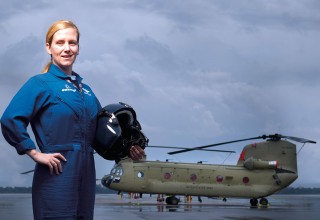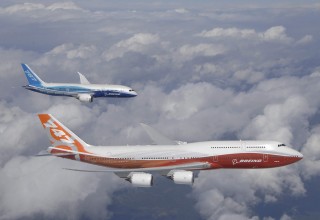Premier Traveler Has Taken a Flight of Its Own
While the Boeing Company is an American institution that has been shaping the aviation industry since the era of biplanes, and like other aerospace companies has also been pushing the boundaries of the traditional workplace by actively recruiting and reaching out to female workers, and creating an atmosphere in which they can thrive.

New York, New York, November 21, 2015 (Newswire.com) - Premier Traveler, based on text from the Boeing book Trailblazers, by Betsy Case, as well as letters from Boeing’s Centennial Story Sharing site, we take a look at how this company got workplace equality right.
Female Firsts—For Both Genders
"This incredible article by Janet Forman is merely a glimpse of the inspiration you will find in the book Trailblazers: The Women of The Boeing Company by Betsy Case," says Executive Director of PT Adam Rodriguez. "We thank everyone at The Boeing Company who helped make this article possible and author Betsy Case for sharing her hard work with us."
Adam Rodriguez, Executive Director
Along with offering a captivating social history that honors the company’s female employees, Trailblazers reveals that women were involved in flight well before the Wright Brothers’ time. In the late-1700s, female balloonists were popular carnival attractions, the book tells us, but it was not until the early 20th century that first wave of daring females entered the era of powered flight. According to Women in Aviation International, E. Lillian Todd was the first woman to design and build an aircraft in 1906, Blanche Stuart Scott was the first female to solo an airplane in 1910, and Katherine Stinson became the first female aerobatic pilot in 1915.
Indeed, many women have broken ground for both genders. In 1921, Bessie Coleman was the first African-American, male or female, to receive a pilot’s license, while Jacqueline Cochran, the first woman to break the sound barrier and the first woman to fly a bomber across the Atlantic, still holds more distance and speed records than any pilot. Barbara Erickson London, a World War II Rosie the Riveter, was not only the first woman to build and fly a B-17, she was also the first pilot of either gender to fly four consecutive 2,000 mile ferry trips, racking up 8,000 miles in five days. (London’s personal legacy is just as enduring: Two of her daughters and three of her grandchildren became pilots.) And while many Boeing employees work far beyond traditional retirement age, the record holder is a woman: Diana Rhea, who started at Boeing in the early days of World War II, was still on the job in November of 2013, 71 years later.
The Thrill of Flight
The thrill of flight knows no gender. When Megan Robertson, the first female to test a Chinook helicopter, saw her brother participate in a water landing of a CH-46D Chinook Sea Knight, she thought, “Wow! Sign me up!” Patricia Beckman, the first woman to qualify as a crewmember on the F-15 and the F/A-18, was inspired to fly when testing of a Saturn V rocket shook the earth near her Huntsville, Alabama hometown. And Rose Loper—Boeing’s first female pilot and the first woman to graduate with honors from the US Army Flight School at Fort Rucker, Alabama—says the greatest appeal was simply the joy of controlling something that’s flying through the air.
Ideas that Transformed Culture
Women have also come to aeronautics from wildly diverse backgrounds. NASA astronaut Mae Jemison, a science-mission specialist on the Rockwell-built Space Shuttle Endeavour, and the first African-American woman in space, was first a physician and a chemical engineer. Bessie Marie Dempsey, Boeing’s first female aeronautical engineer, was a ballerina who danced on stage, in vaudeville acts, and in the Marx Brothers’ movie A Night at the Opera. These diverse backgrounds gave rise to ideas so unique they not only changed aviation, they fundamentally altered the culture.
The concept of flight attendants, for example, came from Ellen Church, a registered nurse and licensed pilot who arrived at Boeing Air Transport hoping to fly planes. She didn’t get the job, but before this determined young woman left the room, she had convinced the predecessor of United Airlines to try a daring new notion: Putting nurses aboard passenger planes to combat the public’s trepidation in those early days of flying. To work easily inside the cramped aircraft of that time these women had to be small—under 5-feet-4 inches and less than 115 pounds—yet their duties included brawny tasks like hauling luggage and pushing aircrafts into hangers. The eight young nurses that were hired in 1930 had three months to prove their value; 85 years later, commercial flights don’t take off without their successors.
Carolyn Corvi, the first woman to lead a Boeing airplane program in 1973, not only helped establish an industry-changing swift-moving assembly line, but her ideas for colorful, light-filled factories earned a 2005 Laurels Award from Aviation Week & Space Technology magazine. Boeing executive Laurette Koellner, who started her career as a secretary and wound up in the Office of the Chairman as Chief People and Administration Officer, advanced the optimistic business philosophy that “everything that comes your way is an opportunity.” And Anna Eleanor Roosevelt ushered in a new view of corporate philanthropy: far beyond gifts and grants, she felt that helping local communities sustain themselves would be the key to lasting change.
It’s About Attitude
Many women come to Boeing with a fierce, uncompromising attitude, and a brand of perfectionism that is at the core of the aerospace industry. Mae Jemison, a physician, engineer and astronaut, says she has always sought out challenges that require creativity, focus and self-reliance. In space, she explains, “you don’t get a chance to say ‘oops.’”
These women are also independent thinkers. Bonnie Soodik, who began as a computer programmer and became the first woman to head Boeing’s Office of Internal Governance, maintains that it is key to “have passion for what you do, and the courage to do the things you fear. Be bold.” Which to Soodik also means “being yourself and standing up for what you believe in, even if you have to stand alone.”
“Care about what you do,” declares Chinook helicopter pilot Megan Robertson. “Seek out opportunities, and don’t let anyone ever say no to you.” Case in point: Sandra Jeffcoat, the first female African American member of Boeing’s Technical Excellence program. The first in her family to attend college, Jeffcoat went on to obtain an MBA and a PhD, but first had to overcome un-thinkable racial and sexual discrimination. Recruited to interview for an information technology job in the early 1970s, Jeffcoat was told she would be rejected because she was female and black. Her response? Let me talk to the boss. She asked for the job personally, got it, and says she has “been proving people wrong ever since.”
When Elinor Otto, one of the original Rosie the Riveters, began working for Boeing in 1942, she was propelled by a wave of optimism and pride. “We were part of this big thing,” she recalls. “We hoped we’d win the war. We worked hard as women, and were proud to have that job.” It’s an attitude that has sustained her: At age 94, she’s still working for Boeing.
The Zeitgeist: Boeing Friends and Family through the Generations
As part of its Centennial Celebration, Boeing has invited employees, retirees and admirers to contribute their thoughts to a Story Sharing site. Similar to the responses Premier Traveler received from readers about their own first flights, Boeing’s request brought a tidal wave of emotional letters. Below are excerpts from just a few:
“I am a 29-year-old Kenyan girl and a real Boeing enthusiast,” writes Winnie Wanzetse. “I grew up loving planes, and for the longest time I believed that all jets were Boeing jets. I waited a long time for my first flight, and the airline through which I booked the ticket had different fleets; my only prayer was that I be assigned to a Boeing plane. My prayers were answered, and thus I got my first-ever flight on a Boeing.”
“Both my father and my grandfather were Boeing engineers, and back in the day, my grandmother was in the secretarial typing pool,” writes third-generation employee Sharon Bernhardt. “Every time I step onto a plane and see that it was built by Boeing, I stand a little taller and walk a little more confidently because I know how solid that legacy is.”
Current employee Julie Beal has also had close family members employed by Boeing since 1946. “I’m so incredibly proud of the legacy my family has made here at Boeing. It truly brings tears to my eyes. From the moment I started working at this company, I always felt as if I was part of something bigger than myself.”
Michele J. Fay-Lonsdale, who carries on the legacy of her mother, a Pan Am stewardess, and her father, a Pan Am pilot, has had a front row seat to history as a Boeing van and limousine driver. “I’ve been in motorcades, I’ve driven ambassadors and CEOs of airlines,” she reveals. “On the first flight of the 787, I transported the captain’s family.” Fay-Lonsdale’s niece and her husband were diplomats in Angola when that country received its first 777, so there was a family connection then, too. “I transported the Angolan ambassador to Everett, Washington, for the delivery flight, and my niece was at the other end waiting when the plane landed for the huge celebration there.”
Artist Carole Eitzen vividly recalls the day astronauts landed on the moon, as she began working at the Johnson Space Center in Houston in 1967, providing graphics support for the Apollo program. “July 20, 1969, when they landed on the moon, was one of the highlights of my life,” Eitzen recalls. “My office was on the same floor as their conference room and our group was invited to watch the moon landing there. There were screams and shouts and prayers when they saw on the big screen: ‘Mission accomplished.’ We had chills. It was an exciting time.”
Another employee who will always recall her moment in Boeing history is Dorothy Carrig, a parts expediter who appeared in Popular Science magazine many decades ago, comparing her tiny diamond wedding ring to the huge industrial diamonds used on the factory floor. “Three of my children worked at Boeing and my two youngest retired after long careers in 2015,” notes Carrig. “My daughter-in-law and granddaughter still work in the Seattle offices. On the Boeing Centennial Anniversary I will be 99 years old. You beat me by a year, Bill!” she declares.
At the same time, employees like Sarah Brown are looking toward the future. Brown first learned about Boeing as a child, when her father worked on the V-22 Osprey and the early International Space Station. “I started to look up at night to find some far-off star twinkling in the distance,” she recalls, “and I would think, ‘My dad is working to get us out there, and I’m gonna get out there one day, too.’ I am now chief of staff for the Space Launch System program with Boeing.” Brown is proud to be working on the next generation of space travel. “Every day, I get to be part of the team that’s making strides in history to take humans on their first journey to Mars. Now, I get to look up into the sky at the passing space station and think. ‘My dad did that, and my team is going to take us beyond.’”
Diversity: Good for the Workplace, Good for the World
Back on earth, Boeing engineer Mary Armstrong, named vice president of Environment, Health and Safety in 2007, feels that encouraging diversity doesn’t just benefit women and minorities. In her continued efforts to improve the environmental performance of Boeing products, she observes that a diverse engineering workforce—one that includes men and women—is not only good for engineering; it’s good for business, good for the world, and one legacy of a century’s commitment from Boeing. By Janet Forman
About Us: Premier Traveler (PT) was created as an outlet for its readers’ voices to be heard. Perpetually on-the-go (both domestically and abroad), with high expectations and a taste for luxury, Premier Traveler readers always have something to share—a personal experience, an opinion, a suggestion, a question—and PT was designed to listen and to get the answers they need.
The open dialogue doesn’t stop with letters and emails from readers. Premier Traveler goes one step further by creating frequent questionnaires on a variety of topics, allowing the editorial team to inject the magazine’s content with valuable and relevant insights.
As perennial global travelers, PT readers demand premium products and services but can still appreciate a good deal. That’s why they turn to Premier Traveler for the latest travel news and information, while also learning about exciting promotional offers and losing themselves in candid hotel and flight reviews. This is part of what makes Premier Traveler more than just another magazine, but one that shares a personal connection with its readers.
AWARD WINNING JOURNALISM
2013 “Best Magazine Article: U.S. Travel”
2013 “Best Magazine Article: Foreign Travel”
2013 “Best Business Travel Media Award”
2014 “Bill Muster Gold Award: Cultural Category”
2014 “Best Magazine Article Foreign Travel: The World's a Stage”
2014 “Best Magazine Article Foreign Travel: Lisbon’s New Lease on Life”
2014 “Best in-depth coverage on travel theme: Series on Women in Travel”
2014 “The Business of Travel, Second Place: Meet in the Cloud Forest”
2014 “Best Photography, Action, Second Place: Shark Tank (Dubai)”
2015 “Best Magazine Article: Romance”
2015 “Best Magazine Article, Second Place: Food and Wine”
